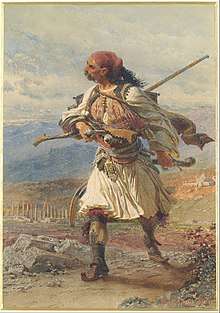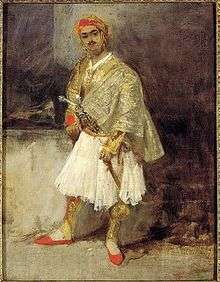Armatoloi
Armatoloi (Greek plural Αρματολοί; singular Armatolos, Αρματολός; also called Armatoles in English) were Christian Greek irregular soldiers, or militia, commissioned by the Ottomans to enforce the Sultan's authority within an administrative district called an Armatoliki (Greek singular Αρματολίκι; plural Armatolikia, Αρματολίκια).[1] Armatolikia were created in areas of Greece that had high levels of brigandage (i.e. klephts), or in regions that were difficult for Ottoman authorities to govern due to the inaccessible terrain, such as the Agrafa mountains of Thessaly, where the first armatoliki was established in the 15th century. Over time, the roles of the armatoloi and klephtes became blurred, with both reversing their roles and allegiances as the situation demanded, all the while maintaining the delicate status-quo with the Ottoman authorities. They were armed men who were enforcing the law according to their desires with the force of their guns, armata, since the authority of the Ottoman Empire was very limited in the areas that they were acting, as the Ottoman empire where the Armatoloi were present was a failed state.[2]

During the Greek War of Independence, the armatoloi, along with the klephts, formed the nucleus of the Greek fighting forces, and played a prominent part throughout its duration. Yannis Makriyannis referred to the armatoloi and klephts as the "yeast of liberty" (μαγιά της λευτεριάς).[3]
Etymology
The word armatolos first appeared in the 15th century during Venetian times. It is derived from a medieval loan from Latin arma ('weapon'), probably via Greek αρματολόγος ('someone who deals with arms', 'an armed person') → αρματολόος → αρματολός. According to an older hypothesis, the development of the word may also have been influenced by a conflation with the similar-sounding αμαρτωλός ("sinner"; cf. hamartia), which may have been associated with the topic of armed bands through phrases such as "αμαρτωλοί/αρματολοί και κλέφτες" (meaning "sinners and thieves", but also "armatoloi and klephts"). Owing to the parallelism with "αμαρτωλός", the word was also sometimes spelled as "αρματωλός", with the letter omega.[4]
Origins and structure

The military/police organization of the armatoloi, known as armatolismos, has its origins in the Byzantine period of Greek history.[1] Armatolismos was a type of feudalism where police and military functions were provided in exchange for titles of land.[1] As an institution, the armatoloi first appear in Agrafa, Thessaly during the reign of Sultan Murad II (r. 1421–1451). From there, they spread to other parts of Greece except the Peloponnese.[5]
Administrative districts known as armatolikia were created in areas of Greece that had high levels of brigandage (i.e. klephts), or in regions that were difficult for Ottoman authorities to govern due to the inaccessible terrain. An armatoliki was commanded by a kapetanios (from Italian capitano meaning captain),[6] often a former klepht captain who had been hired by the governing Ottoman pasha to combat, or at least contain, brigand groups operating in the region. In most cases, the captain would have gained a level of notoriety as a klepht to force the Ottomans to give him amnesty and the privileges that came with an armatoliki. Therefore, it was not surprising that armatolos units were organised in very much the same way as the klephts, with a captain assisted by a lieutenant called a protopalikaro, who was usually a kinsman, and the remaining force made up of armatoloi. Many captains ran their armatolikia like their personal fiefdoms, exacting a heavy toll of extortion and violence on the local peasantry.
Ottoman period
As mentioned earlier, the armatoloi were organized based on a feudal system under which they maintained their military/police duties in exchange for titles of land.[1] When the Ottomans conquered Greece in the 15th century, they established treaties with the armatoloi in order for them to maintain their military/police functions.[1] The Ottomans would have units of armatoloi or kapetanioi (καπετάνιοι, captains) function as peace-keepers in territories near difficult terrain (i.e. mountain passes) or in areas where resistance to foreign rule entailed acts of theft by the klephts.
The armatoloi were mostly concentrated in Macedonia, Thessaly, Epirus, Acarnania, and Aetolia (specifically Agrafa). In the Peloponnese, armatolismos did not develop in the same manner as it did in Roumeli and Epirus. In the Peloponnese, the kapoi (κάποι) and the meintanides (μεϊντάνηδες) were similar to the armatoloi. If in certain regions, the institution of armatolismos was not implemented, the territories were divided into armatolikia (αρματολίκια) or protakta (προτάκτα). These territories extended from the Axios River (Αξιός) to the Ambracian Gulf (Αμβρακικός) and up to the Corinthian Gulf (Κορινθιακός). The kapetanioi would often have authority over these territories via inheritance/succession. A single kapetanio was at first forced to submit his authority to the pasha who controlled the periphery. Later, all kapetanioi were forced to submit to Dervedji pasha (Δερβετζή πασά).
During the 18th century, there were around seventeen armatolikia. Ten of them were located in Thessaly and the eastern regions of Central Greece, four of them in Epirus, Acarnania, and Aetolia, and three in Macedonia. Every kapetanio had his rank-and-file soldiers known as palikaria (παλικάρια, from ancient Greek pallix) and section leaders among these palikaria were known as protopalikara (πρωτοπαλίκαρα).[6] The palikaria would train with their weapons on a daily basis.
The main weapon the palikaria utilized was the kariofili (καριοφίλι).[8] Marksmanship was the proverbial hallmark that defined the palikaria. They were also high mobile and capable at conducting ambushes. The palikaria were resilient toward thirst, hunger and even the painful difficulties in their encounters with the klephts.
The term klephtopolemos (κλεφτοπόλεμος) was used to name the strategies/tactics that both the klephts and armatoloi utilized. These tactics are used today for unconventional military campaigns by small guerrilla groups. The armatoloi would conduct campaigns during nighttime. This strategy was known as "going out to pagana" (έβγαιναν στην παγάνα). The armatoloi would usually do this when the klephts were coming out of their dens. The armatoloi would defend themselves in improvised forts (called meterizia; μετερίζια) against the guerrilla tactics utilized by the klephts (specifically known as klephtouria; κλεφτουριά). A general offensive campaign by the armatoloi was known as giourousi (γιουρούσι). During one of these campaigns, the armatoloi would make effective use of swords and warcries.
Before 1821
For the Ottomans, it became progressively more difficult for them to distinguish the armatoloi from the klephts. Both groups began to establish relations with one another under a common ethnic Greek rubric. This collaboration was also based on mutual sentiments against foreign conquerors. Since both groups were armed and possessed military experience, they helped Greeks become better warriors before the advent of the Greek Revolution of 1821.
The first recorded appearance of collaborations between armatoloi and klephts goes back to 1585 during the wars fought between the Venetians and the Ottomans. During this time, Theodoros Boua-Grivas incited an insurrection in Acarnania and Epirus with armatoloi Poulios Drakos and Malamos from Epirus. The Sublime Porte continued to have trust in armed groups such as the armatoloi up until 1684. During that year the armatoloi became carriers of nationalist ideas. Prominent armatoloi from the 17th century were Soumilas (Σουμίλας), Meintanis (Μεϊντάνης), Livinis (Λιβίνης), Kourmas (Κούρμας), the Balaorites (Βαλαωρίτες), etc. Though these individuals engaged in failed rebellions, their attempts became an inspiration for future armatoloi to follow.
Revolution of 1821
Since the 1770s, the Russian Empire tried to inspire a rebellion in Greece (see Orlov Revolt). During these attempts, many armatoloi took up arms. With the outbreak of the Greek War of Independence, (an insurrection in which Russia had, for once, no involvement as an instigator or agitator) a number of prominent armatoloi abandoned any allegiance to the Ottoman state and formed the nucleus of the Greek land forces. Among them were Odysseas Androutsos, Georgios Karaiskakis, Athanasios Diakos, and Markos Botsaris. There were armatoloi (such as Karaiskakis) that were initially employed by Ali Pasha, and of whom some fought with him against the Ottomans. In 1820, when Ali declared his territory’s withdrawal from Ottoman influence, he depended heavily on the Greek armatoloi to help him. Though Ali’s insurrection failed, this bold experiment did not weaken the ability of the armatoloi to fight for independence and contribute to the Greek Revolution.
Albanian militia
There was also the Albanian armatoli, mostly a private militia of Christian Albanians, with privileges given by the Sultan in 1861.[9] During the Austro-Turkish War (1716–1718), the militia caused trouble in Kavala resulting in it being abolished in 1721 by Ahmed III.[10]
Famous armatoloi
- Athanasios Diakos
- Georgios Karaiskakis
- Giorgakis Olympios
- Krokodeilos Kladas
- Odysseas Androutsos
- Giannis Stathas
References
Citations
- "armatole". Encyclopædia Britannica. Encyclopædia Britannica, Inc. 2014. Retrieved 8 October 2014.
- "armatole". Istoria tou Ellinikou Ethnouw. 2014.
- Vacalopoulos 1961, p. 333: "Οί πυρήνες τών μαχητικών του δυνάμεων είναι οί άρματολοί καΐ οί κλέφτες...ν'άποτελέσουν τήν «μαγιά της λευτεριάς», όπως παραστατικά λέγει ό άγωνιστής τοϋ 21 Γιάννης Μακρυγιάννης."
- Babiniotis 1998.
- Vacalopoulos 1976, p. 211: "The earliest origins of the armatoles are lost in the murk of history. However, in my Origins of the Greek Nation, an analysis of various sources not previously sifted in any thorough way suggested that the institution first appeared in Thessaly during the reign of Murad II (1421–1451), specifically in the Agrafa, Thessaly. From there, it subsequently spread to other parts of the Hellenic world, though not to the Peloponnese."
- Vacalopoulos 1976, p. 212: "The district over which the armatoles' authority extended was called an armatoliki. Commanders were known as capetanos or capetanios (from the Italian capitano), the rank and file as pallikaria (from the ancient Greek pallix, -ikos), and section leaders as protopallikara."
- Dakin 1973, p. 232 (Footnote #1): "[Dimitrios] Makris, armatolos of Zigos, was one of the heroes of Mesolonghi. He had acquired much wealth by plundering the Turks of Vrachori, and he had done well for himself out of the proceeds of the English loans."
- A front-loading gun from Cario & Figlio, an 18th-century maker of such guns.
- 1861 | George Finlay: The Albanians. Retrieved 15 December 2019.
- Ring, Trudy; Watson, Noelle; Schellinger, Paul (2013). Southern Europe: International Dictionary of Historic Places. Routledge. ISBN 978-1-134-25958-8. Retrieved 15 December 2019.
Sources
- Babiniotis, George D. (1998). Λεξικό της Νέας Ελληνικής Γλώσσας (in Greek). Athens, Greece: Kentro Leksikologias. ISBN 978-9-60-861900-5.CS1 maint: ref=harv (link)
- Dakin, Douglas (1973). The Greek Struggle for Independence, 1821–1833. Berkeley and Los Angeles: University of California Press. ISBN 0-520-02342-0.CS1 maint: ref=harv (link)
- Vacalopoulos, Apostolis (1961). Ιστορία του Νέου Ελληνισμού [History of Neo-Hellenism]. 2. A.E. Vakalopoulos.CS1 maint: ref=harv (link)
- Vacalopoulos, Apostolis (1976). The Greek Nation, 1453–1669. New Brunswick, NJ: Rutgers University Press.CS1 maint: ref=harv (link)
Further reading
| Wikisource has the text of the 1911 Encyclopædia Britannica article Armatoles. |
- Brewer, David (2011). The Greek War of Independence: The Struggle for Freedom from Ottoman Oppression. New York and London: Overlook/Duckworth. ISBN 978-0-71-564161-3.
- Paroulakis, Peter Harold (1984). The Greeks: Their Struggle for Independence. Darwin, Northern Territory (Australia): Hellenic International Press. ISBN 978-0-95-908940-0.
| Look up armatole in Wiktionary, the free dictionary. |
